McIntosh MA252 Integrated

 Some manufacturers stand above the crowd based upon decades of history and legend. Were you at Woodstock? McIntosh was. Ever hear the Grateful Dead’s famous Wall of Sound? Yep, McIntosh. Since its founding in 1949, McIntosh has played an important role in our musical heritage. McIntosh’s distinctive style and immediate brand recognition make it popular for cameo appearances such as in Sherlock Holmes’ audio system in the television series “Elementary” and in the Amazon series about Detective Hieronymus “Harry” Bosch. Many are familiar with the brand name and unique appearance but may not be familiar with its storied legacy.
Some manufacturers stand above the crowd based upon decades of history and legend. Were you at Woodstock? McIntosh was. Ever hear the Grateful Dead’s famous Wall of Sound? Yep, McIntosh. Since its founding in 1949, McIntosh has played an important role in our musical heritage. McIntosh’s distinctive style and immediate brand recognition make it popular for cameo appearances such as in Sherlock Holmes’ audio system in the television series “Elementary” and in the Amazon series about Detective Hieronymus “Harry” Bosch. Many are familiar with the brand name and unique appearance but may not be familiar with its storied legacy.
Although I am not a legend (yet), I personally used a McIntosh solid-state integrated for almost 20 years through multiple speakers. For all I know it is still in service somewhere as McIntosh equipment 40-years old or more is routinely offered on eBay. That is the kind of longevity McIntosh is famous for. Accomplishments like these do not happen by accident. Building a loyal and dedicated customer base demands constant attention to performance, durability, customer service, and value. If you rest on your laurels, you end up getting left at the side of the road. And seven decades is truly a long and winding road. I can only think of one audio company, Quad, with older roots.
Purchasing a new home has allowed me to expand to a second system. At the same time, I am striving to keep both systems simple, modestly priced, and individual component weight under 40 pounds. Purchasing an MA252 was in some ways a homecoming for me. As soon as I saw the product announcement I knew I wanted one. I was not alone. Initial orders exceeded production capacity. McIntosh is not a company to be hurried. Each piece is hand-built to tight quality control in Binghamton, NY.
The wait was worth it. I have had more than my share of audio equipment pass through my home but, with the exception of my Quad ESL-2805s in the beautiful Classic Finish, few have captured my heart. Yes, most of the equipment gave satisfactory to excellent performance, but nothing but my Quads, and now the MA252 gave me warm-fuzzies when I turned it on. Yes, the McIntosh-glow is seductive but so is the solid musical performance.
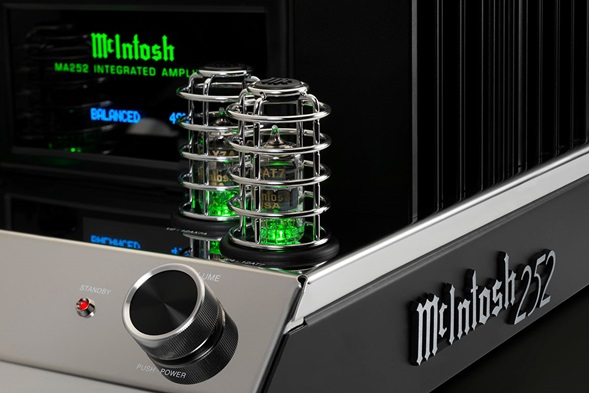
Features
While I understand the benefits of having an integrated unit with all the latest digital and streaming options built in I also understand the drawbacks of such designs. With equipment designed and built to last decades saddling it with quickly-dated digital functions can be counterproductive. For some users it is a better option to purchase a solid core of long-lived analog technology and allow the always changing digital functions to reside in peripherals.
Some things just go together like peanut butter and chocolate or cake and ice cream. Many audiophiles, myself included, prefer a tube front end followed by the control and power of solid state amplification. McIntosh’s first hybrid integrated amplifier marries these functions in one affordable compact package. And it is a marriage made in heaven. All I can say to the McIntosh engineers is “great idea – what took you so long?”
The MA252 preamplifier stage uses two 12AX7 and two 12AT7 vacuum tubes housed in protective cages with LEDs that glow orange during warm-up and soft, McIntosh green, when operational. The LEDs also flash amber if needed to indicate trouble in paradise. The MA252 uses McIntosh’s Power GuardR technology to guard against clipping via monitoring the output signal and real-time micro adjustments to the input signal if necessary. According to the McIntosh website, “If Power Guard is activated, the 2 vacuum tubes connected to the affected audio channel(s) will flash an orange color and return to their normal green color when the clipping has stopped.”
The output stage is a direct-coupled solid-state Class A/B amplifier rated at 100WPC (8ohms) and 160WPC (4ohms). A large R-Core transformer, plus capacitor storage and regulated power supply maintain performance despite voltage fluctuations from the line in. Inputs include one pair of balanced, two pairs of unbalanced, and one phonograph (with ground) input suitable for moving magnet or high output moving coil such as found on the new McIntosh MT2. There is also a full range mono output for connection to a powered subwoofer but there are no preamplifier outputs.
Although the inputs can be named, with only four, it is easy to toggle through them using the stylishly slim remote. Unused inputs can be turned off to avoid scrolling through them each time. Input selection and volume level are both displayed on the face plate of the MA252 but the small size makes them hard to read in many installations. The information display (but not the McIntosh logo) can be programmed to only light briefly when changes are made. Bass and treble trim controls offer 10dB of boost or cut individually for each input and the MA252 remembers the settings for each input.
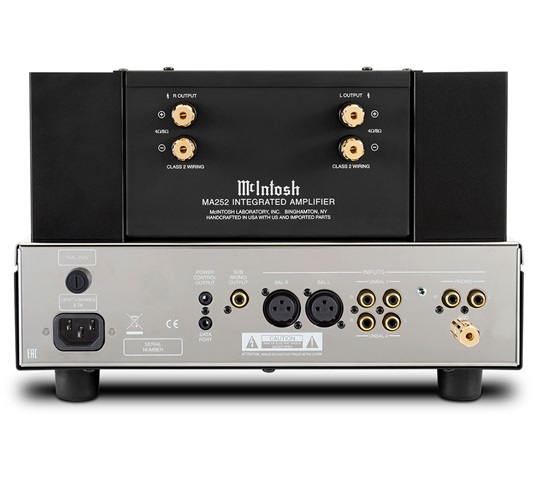
The rear panel contains two 3.5mm stereo mini phone plugs. One for power on/off(+12V/0V) for use with other McIntosh equipment. The other is a data output port that, combined with the remote, control McIntosh source components. The remote uses the normal McIntosh control codes but alternate codes can be accessed to avoid interference with nearby McIntosh preamplifiers or A/V processors. These are important features if you have additional McIntosh equipment.
In the center of the remote is a “Select Trim” function button. Engaging it enables scrolling through a menu that allows the listener to adjust treble, bass, balance, and the display. These functions can also be accessed via pressing the left knob on the unit. Turning that knob selects inputs. The right knob controls on/off/volume and is used to change settings in conjunction with the left knob. The only other features gracing the spartan control panel are a red standby light and a headphone jack optimized for 20-600 ohms. Interesting features are the ability to defeat the IR function if there are compatibility issues with nearby equipment and a defeatable auto-off feature that turns the unit off after 30 minutes without an audio signal or user activity.
The slim remote supplied with the MA252 can also control other McIntosh equipment such as a CD player. The remote paired with the MA252 has the widest (by far) angle of operation of any remote I have ever used. I can stand at a 45-degree angle at 18′ away and, if I cock my arm at the correct angle, the remote works. Yes, I measured the distance I was so incredulous! This feature came in very handy for use while I was working in the kitchen portion of my great room. Domestic chores go easier with toe-tapping music. The only downside to the remote is a touchy on/off button. If I press a little to hard or long the MA252 restarts and I have to wait for the startup cycle to end before I can turn it off.
McIntosh patented gold-plated binding posts accept bare wire, spades, and banana plugs. A special fiberglass-reinforced nylon wrench is supplied so no damage will happen to the gold plating. Sometimes the simplest things can delight. The wrench was the perfect tool to get tight connections without damaging the beautifully finished posts. I wish all manufacturers would supply such useful accessories. The wrench is definitely worthy of a separate purchase if it was offered.
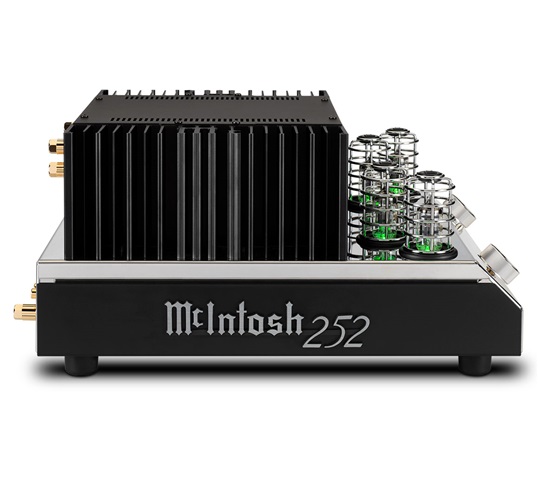
Where’s the Heat?
McIntosh claims the high current output transistors used in the MA252 virtually eliminate warm up time. I can testify that I did not notice any change in performance from amplifier turn-on to turn-off. But I also do not notice much of a change in temperature. The owner’s manual suggests providing at least 6 inches above the top of the unit for ventilation but I have found that to be overly cautious. In my home theater installation, I only had two inches above the MA252 and, after hours of operation, the oversized McIntosh Monogrammed Heatsinks™ never felt warm to the touch. The caveat here is the rack is entirely open so ventilation is very good. In my two-channel installation there is 3 inches of overhead clearance in my open, single-width Adona rack. After four hours playing at 65% volume level, I used a multi-meter with temperature probe to measure temperature against the chassis deep between heat sink fins. The MA252 measured 870F in a room that was 690F.
Listen up
I initially installed the MA252 on Tekton Electron (4 Ohm, 95dB efficiency rating) speakers in my 18’x37’x9’H great room. This was for burn in purposes only since my home is brand new and I am still getting systems and rooms set up. There is no acoustic treatment in the room (work in progress) and bare walls, tile floors (listening area is padded carpet), granite counter tops and 55″ television present an acoustic challenge. It would be unfair to give any evaluation in that room at this point. I only mention this to relate that the MA252 could power the speakers to painful volume levels at its 70% setting. When paired with the right speakers the MA252 should provide more than adequate power to fill any listening room.
For performance evaluation the MA252 was installed on my Quad ESL-2805s in my dedicated two channel system. My source was a Laufer-Teknik Memory Player 64 (32-core). All cables were JPS Labs Aluminata. A very simple system that will have a turntable added in the future. The MA252 has me covered there as well.
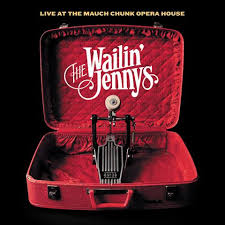 What a surprise! The first track I played was The Wailin’ Jennys version of “Deeper Well” from their CD Live at the Mauch Chunk Opera House [Red House Records RHR CD 220]. The MA252 is every bit as fast as the Quads demanded. Attacks were crisp and dynamic. There was an excellent visceral impact to the upright bass and bodhrán. This amp is no milquetoast. I worked my way through the remainder of the well-recorded live album. On the a Capella version of “Summertime” harmonizing of the three female vocalists was captivating. I could hear at least one of the ladies take a deep breath each time in the short, quiet space between lines just before the next line of the song began. Like a whisper in reverse. Is that quiet enough for you?
What a surprise! The first track I played was The Wailin’ Jennys version of “Deeper Well” from their CD Live at the Mauch Chunk Opera House [Red House Records RHR CD 220]. The MA252 is every bit as fast as the Quads demanded. Attacks were crisp and dynamic. There was an excellent visceral impact to the upright bass and bodhrán. This amp is no milquetoast. I worked my way through the remainder of the well-recorded live album. On the a Capella version of “Summertime” harmonizing of the three female vocalists was captivating. I could hear at least one of the ladies take a deep breath each time in the short, quiet space between lines just before the next line of the song began. Like a whisper in reverse. Is that quiet enough for you?
One thing to note here is I could activate the Power GuardR protective circuit at a setting above 80% on the Quads using the “Deeper Well” track. The circuit activation was very fast and returned to normal operation (green light for go) quickly indicating the MA252 had made instantaneous adjustments to the input level. If I had not been looking at the amplifier I would not have noticed it because there was no audible telltale. The ESL-2805s present a challenge with their 4-15 Ohm range and 86dB efficiency. But that is absolutely not a problem for the MA252 even at loud volume. The volume that caused clipping was considerably above a sane listening level. It was just part of my evaluation routine. Hey, I had to see if Power Guard really worked didn’t I? Mandatory test drive redlining, slap the “Ludicrous” button!
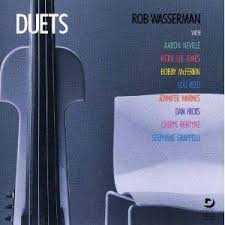 A favorite test track of mine is “Ballad of the Runaway Horse” featuring Jennifer Warnes with Rob Wasserman from the CD Duets [Rounder 11661-3227-2] included in the box set, Trilogy [Rounder 11661-3225-2]. With the MA252 Jennifer’s voice was pure and clean. Some nuance was lost in the background vocals. In my system, I have heard, and prefer, more definition from Wasserman’s upright bass. But the integrated amplifier that did that cost twice the price and left me wanting more warmth. The separates (preamplifier plus amplifier) that outperformed cost 3.5 times as much ignoring the extra power cord and interconnect pair required. What I again noticed on this track was how quiet the MA252 was. There was no tube his or other electronic noise.
A favorite test track of mine is “Ballad of the Runaway Horse” featuring Jennifer Warnes with Rob Wasserman from the CD Duets [Rounder 11661-3227-2] included in the box set, Trilogy [Rounder 11661-3225-2]. With the MA252 Jennifer’s voice was pure and clean. Some nuance was lost in the background vocals. In my system, I have heard, and prefer, more definition from Wasserman’s upright bass. But the integrated amplifier that did that cost twice the price and left me wanting more warmth. The separates (preamplifier plus amplifier) that outperformed cost 3.5 times as much ignoring the extra power cord and interconnect pair required. What I again noticed on this track was how quiet the MA252 was. There was no tube his or other electronic noise.
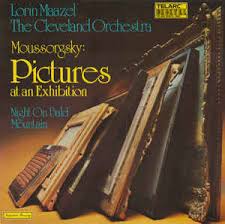 On the CD Mussorgsky: Night on Bald Mountain/Pictures at an Exhibition (Lorin Mazel-The Cleveland Orchestra)[Telarc CD-80042] the agility of the MA252 was exhibited as it deftly follows the fast-paced strings. It scaled easily from almost silent to impressive full orchestration with a feel-it-in-your-gut impact and spacious soundstage and no clipping. It appears this amplifier only clips if someone goes a little crazy and has a deaf-wish. Many amplifiers will act the same way, they just won’t have warning lights to say “back off dummy”. I would have liked more definition between the instruments during full orchestration. This is the only area where I can fault the MA252 slightly. Inner detail is not one of its strengths. I have heard better and I have heard much worse. But I am kind of a nut for detail. That is one reason I own Quads.
On the CD Mussorgsky: Night on Bald Mountain/Pictures at an Exhibition (Lorin Mazel-The Cleveland Orchestra)[Telarc CD-80042] the agility of the MA252 was exhibited as it deftly follows the fast-paced strings. It scaled easily from almost silent to impressive full orchestration with a feel-it-in-your-gut impact and spacious soundstage and no clipping. It appears this amplifier only clips if someone goes a little crazy and has a deaf-wish. Many amplifiers will act the same way, they just won’t have warning lights to say “back off dummy”. I would have liked more definition between the instruments during full orchestration. This is the only area where I can fault the MA252 slightly. Inner detail is not one of its strengths. I have heard better and I have heard much worse. But I am kind of a nut for detail. That is one reason I own Quads.
Conclusion:
Throughout all the music I played on the MA252 my overriding opinion was one of a well-balanced and always enjoyable presentation. Overall, a solid and consistent musical performance. Not the ultimate in any sense. You do not get ultimate for less than the price of many high-end power cords. There is always more performance to be had at higher prices. The MA252 offers a tremendous value. Value is more than just price and performance. Long term reliability and user satisfaction are also important.
I am amazed that a company like McIntosh can offer so much performance, style, and American-built quality in a package so affordable and user friendly. The MA252s compact size, light weight, and cool operation make it easy to handle and integrate into a system. The MA252 is a component worthy of consideration as the core to an audio system that will allow the user to listen for hours without fatigue. And, based on McIntosh’s reputation for long-term reliability and service, possibly listen for decades.

![]()
don shaulis
Specifications:
Power Output: 100 Wpc (8 Ohms) 160 Wpc (4 Ohms)
Rated Power Band: 20Hz to 20kHz
Inputs: Analog only 2 pairs unbalanced, 1 pair balanced, 1 pair phonograph
Outputs: mono subwoofer, headphone
Total Harmonic Distortion: 0.03%
Dynamic Headroom:1.8dB
Frequency Response: +0,-0.5dB 20Hz to 20kHz
Frequency Response: +0, -3dB 10Hz to 100kHz
Sensitivity Phono: (Moving Coil) N/A
Sensitivity Phono: (Moving Magnet) 3.0mV
Sensitivity High Level: (Balanced / Unbalanced) 0.6V/0.3V
Signal To Noise Ratio: (Moving Magnet) 80dB
Signal To Noise Ratio: (High Level) 97dB
Input Impedance: (Balanced / Unbalanced) 20K/20K
Damping Factor: 8 Ohms: >200; 4 Ohms: >100
Maximum Output: (Balanced / Unbalanced) 8V Unbalanced
Dimensions: (W x H x D) 12″ (30.5cm) x 7-5/8″ (19.4cm) x 18″ (45.7cm)
Weight: 28 lbs (12.7 kg)
Shipping Weight: 37 lbs (16.8 kg)
MSRP: $3500
Address:
McIntosh Laboratory, Inc.
2 Chambers Street
Binghamton, NY 13903-2699
Telephone: 800 538 6576
Website: www.mcintoshlabs.com/
2 thoughts on "McIntosh MA252 Integrated"
Leave a Reply
Stereo Times Masthead
Publisher/Founder
Clement Perry
Editor
Dave Thomas
Senior Editors
Frank Alles, Mike Girardi, Russell Lichter, Terry London, Moreno Mitchell, Paul Szabady, Bill Wells, Mike Wright, and Stephen Yan,
Current Contributors
David Abramson, Tim Barrall, Dave Allison, Ron Cook, Lewis Dardick, John Hoffman, Dan Secula, Don Shaulis, Greg Simmons, Eric Teh, Greg Voth, Richard Willie, Ed Van Winkle, Rob Dockery, Richard Doran, and Daveed Turek
Site Management Clement Perry
Ad Designer: Martin Perry






UPDATED… TYPOS FIXED.
I purchased the McIntosh MA252 about two years ago. It is remarkable and never provides any listening fatigue. It is too good in that it shows poor recordings signatures. Good, high quality recordings sound better than a live performance. Friends of mine hearing it for the first time all tell me that the musicians sound like they are in the room.
I’m a jazz lover and this addition to my system (vintage ADS speakers, ADS CD player, B&O turntable and BluOs plus Qobuz) bring me up to 2024. I’m again caught up to date sonically. I’ve arrived to the forefront of technology again. My but I love the arrival, the product, support and value.
Thank you McIntosh. One of my grandsons will inherit this.
Nice review.., do you think that the Macintosh would have any issues driving a pair of dyn audio Sp 40 .
They are 86 db at 6 ohms , I do like it turned up.
Thanks
Gerald